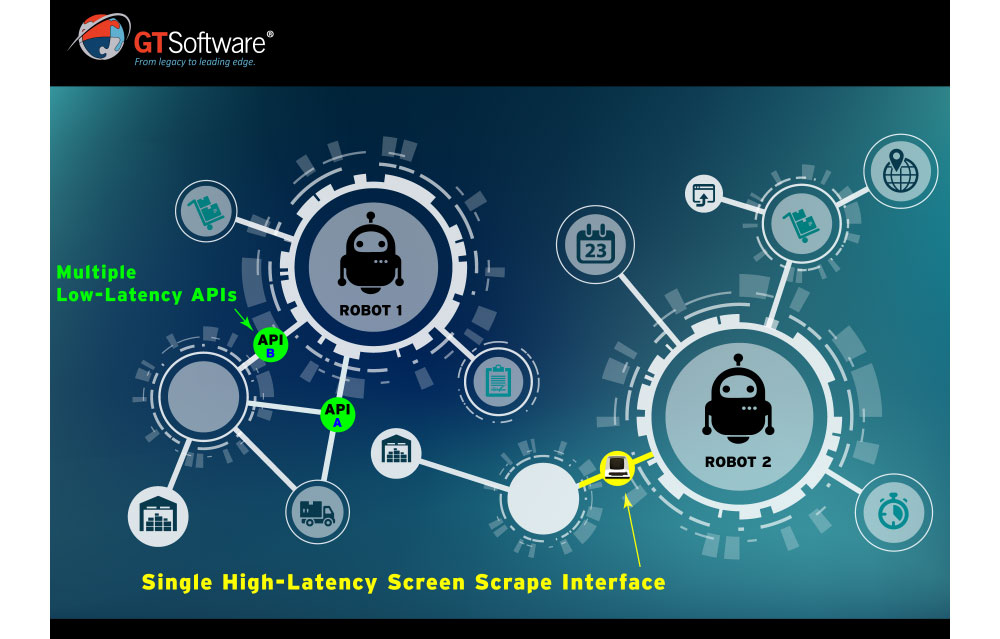Robotic Process Automation (RPA) emerged from a need to perform repetitive business functions that many times required interaction with a mainframe. Rudimentary programs were paired with screen scraping technology to perform repetitive business functions that were not easily programmable. Over time, these technology platforms evolved to integrate with disparate systems, enabling these technologies to mimic the behavior and capabilities of a human – robots and the field of RPA was born. In a separate field, complex business processes that could not be automated gave birth to Business Process Outsourcing (BPO), where complex repetitive business processes that could not be easily automated were outsourced to special purpose teams in geographies with lower cost resources.
A RPA robot’s efficiency is limited by many factors, including the responsiveness of the hardware platform it operates in, how the robot was coded in the first place, whether artificial intelligence was incorporated into the robot, and the responsiveness of the various interfaces and APIs that the robot requires to do its job. In the enterprise, installing a robot manually on a computer was usually a laborious step that limited how these technologies could be deployed.
Virtualization technologies proved to be a giant leap for RPA. With virtualization, managers were able to quickly instantiate vast farms of robots. Instead of having a robot using the resources of a desktop microcomputer, dozens or hundreds of robots could be instantiated on a single server. This approach allowed enterprises to complete large volumes of work in record time, but the virtualization approach came with its own challenges. While the last decades of the 20th century saw a steep decline in technology prices, computer servers still presented a significant expense to the enterprise, particularly when robots instances made up a material component of the data center footprint. Those robots were limited by their own inflexibility and the need to interact with core systems via antiquated integrations.
Fast forward to today, Artificial Intelligence (AI), Application Programming Interfaces (APIs), virtualization technologies (VM), and more elegant approaches to interact with the mainframe have allowed enterprises to instantiate vast server farms of intelligent robots that can perform the repetitive work of tens or thousands of employees.
Today, Artificial intelligence technology is transforming not only RPA but also chipping away at the BPO space. No longer do RPA robots behave according to rigid macro-like programmed steps. Instead, modern robots observe and learn from how humans resolve challenges in a business setting and incorporate the best processes into their problem solving tool set, automatically. Robots also evaluate the various options to perform a task and choose the most productive path. If an inefficient screen scraping pathway is clogged, the robot might choose to solve its business problem by accessing a mainframe via a more responsive API. Aside from learning from humans, robots can observe other robots and streamline business process functions automatically, learning from each other. As these robots work, they become more efficient, allowing them to stretch limited resources.
In figure 1, an intelligent Robot 1 has the choice between two low-latency APIs that were quickly designed using a modern mainframe integration and orchestration suite. As the robot does its job, it might decide that it’s easier for it to directly access distribution data information via API-A. At other times, the robot might decide that API-B yields a more efficient solution.
Using a mainframe integration and orchestration suite, like GT Software’s Ivory, allows RPA architects to quickly create and empower their RPA robot farms with multiple tailor-made APIs, giving the learning robots options to improve themselves. At some point in the future robots might be able to modify or create their own APIs, as needed. Meanwhile in figure 1, Robot 2 is hampered by a first generation high-latency screen scrape integration, and although it’s an AI enabled robot, it can’t reach its full potential.

Most enterprises that are deploying RPA need to make sure that their integration landscape is not reliant on antiquated 3270 green screen scraping technologies. In the modern enterprise, it’s critical to constantly analyze bottlenecks and remove high-latency interfaces from RPA work paths, especially for newer self-learning AI enabled robots that are constantly looking to improve themselves.
-Joe Marroquin, Director, Strategic Alliances
